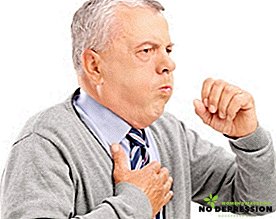Pneumonia is an inflammatory process localized in the lung tissues that interferes with the normal course of the gas exchange process. The disease can occur in an acute and chronic form. In the first case, the symptoms will be more obvious.
Acute pneumonia can be primary, that is, the disease affects an initially healthy organ, or secondary, when inflammation is a complication of another disease.

The causes of the disease
Causative agents of pneumonia are many. They can belong to a group:
- bacteria (pneumococci, staphylococci, streptococci);
- viruses (parainfluenza, enteroviruses, rhinoviruses, adenoviruses);
- fungi (aspergilius and pneumocystisis).
There are also those that are not related to any of these groups, but only their presence is not enough; special conditions are needed to get sick. There are a number of reasons that can provide these conditions. They are different for each age group. The following factors are dangerous for adults:
- chronic pulmonary diseases;

- diseases of the cardiovascular system;
- chronic immunodeficiency;
- prolonged stressful states;
- endocrine system diseases;
- cancer diseases;
- aspiration type pneumonia (swallowing is difficult);
- surgery in the chest and abdominal area;
- prolonged lying (refers to the forced inability to change position);
- drug, nicotine and alcohol dependence;
- advanced age (over 60 years).
Pneumonia: symptoms and diagnosis in adults
Symptoms of pneumonia in each case will depend on what was its causative agent. In the chronic and acute course of the disease, individual symptoms may also not coincide.
In some cases, it is difficult to detect the presence of a problem, but it is advisable to do so as soon as possible so that the treatment can do without surgical intervention. In addition, in its advanced form, the disease is very likely to be the cause of death.
Among the initial symptoms of pneumonia in adults are:
- presence of rhinitis and cough for several days;
- elevated temperature;
- a feverish condition that is not susceptible to the action of antipyretic drugs;
- shortness of breath (if a large amount of lung tissue was affected);
- feeling short of breath;
- feeling of weakness and a high degree of fatigue.
In moments when there is a shortage of air, the patient experiences a strong fear. At the initial stages of the inflammatory process, the doctor may listen to the patient for the presence of fine bubbling rales.
But calling a specialist at home does not guarantee that he will be able to determine only the disease that has formed. Although in patients with pneumonia, the onset of the disease is accompanied by periodic temperature fluctuations and a rare cough.
 Primarily for the diagnosis of pneumonia applied clinical and instrumental methods of analysis and radiographic examination of the chest cavity and organs located in it.
Primarily for the diagnosis of pneumonia applied clinical and instrumental methods of analysis and radiographic examination of the chest cavity and organs located in it.
According to the indications of at least one type of research, the pathological results give reason to suspect the presence of an inflammatory process in the lungs. At this point, patients usually prescribe antibiotics, which helps prevent respiratory failure.
Treatment of pneumonia at home in adults
In most cases, pneumonia is of viral origin, but in any case the effect of bacterial infections is added to it, so the treatment of pneumonia in adults is necessarily accompanied by antibiotic therapy using one or two medical preparations at once.
When choosing a specific drug is required to consider:
- a type of pneumonia;
- the size of the affected area;
- age and general health of the patient;
- the presence of concomitant heart, kidney and lung diseases.
In any case, the process of treatment at home should take into account all the doctor's prescriptions.
Treatment of pneumonia with antibiotics: scheme and duration
The appointment of an antibiotic drug is strictly related to the patient's age. Even an insufficiently effective drug cannot be replaced until three days have passed, or until the patient’s sputum tests have been deciphered.
Most often, pneumonia with the following drugs:
- Ceftriaxone.
White powder, which is injected. It has an antibacterial effect. An individual course of treatment using this tool is determined by the attending physician. Usually an adult is prescribed to use 1-2 g of the drug every day.
To prepare the injection solution, 500 mg of ceftriaxone and 2 ml of lidocaine (1% solution) are needed, and in the case of a dropper, sterile water (5 ml) is used. Such medicine is quite inexpensive, and you can get it by prescription.
- Sefpotek.
Acceptance of this antibiotic is valid for children over 12 years old. Suitable for overcoming pneumonia and other infectious diseases of the respiratory system.
Adults take 200 mg of the drug per day (1 tablet) twice a day (the interval between doses - 12 hours). Completely the course of reception lasts 14 days. The cost of Sefpoteka is about 120 rubles.
- Sumamed.
Available in the form of powder, lyophilisate and tablets. It helps to cure infectious and inflammatory diseases, including pneumonia.
For pneumonia, the drug is taken for three days. Daily dosage is 500 mg. The cost is more than five hundred rubles.

Treatment of pneumonia in adults folk remedies
Folk recipes that help overcome the inflammation of the lungs in adults can be quite effectively combined with pharmacy drugs, but this must be coordinated with your doctor. Below are the most simple and effective recipes:
- Wash half a cup of dark raisins and grind it in a meat grinder. Pour boiling water (200 ml), let stand for about 10 minutes. Take 1.5 cups of infusion daily.
- Pour the dried white figs (3 pieces) with warm milk and cook in it for about 30 minutes. With pneumonia, drinking such a milk broth twice a day in one glass. Continue intake until symptoms subside.
- In 0.5 liters of dry red wine add 50 g of nuts without shell. Put all this on a slow fire and do not take off for about 15 minutes. Take one tablespoon before each meal.
Features of treatment of various forms of pneumonia
When treating pulmonary inflammation in an adult, it is imperative to consider what kind of disease it has:
- Segmental pneumonia (unilateral and bilateral).
 The most characteristic form of adult disease. It has right and left-sided varieties, but bilateral pneumonia is much more common when each lung has its own lesion.
The most characteristic form of adult disease. It has right and left-sided varieties, but bilateral pneumonia is much more common when each lung has its own lesion.
The healing process includes physiotherapeutic procedures, antibiotics, inhalations and the elimination of allergic symptoms. With a segmental type of inflammation, it is recommended that the patient provide the correct posture that will contribute to the improvement of the work of the lungs - this is a half-sitting position.
- Viral pneumonia.
The cause of viral inflammation is exposure to viruses, bacteria, fungi or parasites. At the initial stage (first 2 days), the patient is prescribed antiviral medications (depending on the pathogen, this could be Tamiflu, Ingavirin, Acyclovir, and other means). In addition, the patient is prescribed antipyretic and analgesic drugs. It may be recommended to take cough medicine that helps get rid of sputum.
Antibiotics can be prescribed only if a concomitant bacterial infection is detected.
- Bronchopneumonia.
 This type of disease is also called focal. Its development is promoted by the presence of bronchitis and it has rather dangerous consequences in the form of pleuropneumonia, an abscess or gangrene.
This type of disease is also called focal. Its development is promoted by the presence of bronchitis and it has rather dangerous consequences in the form of pleuropneumonia, an abscess or gangrene.
For this reason, only the doctor has the right to determine the method of treatment for bronchopneumonia. In the course of treatment, antibiotics will be used.
The main criterion for the selection of an antibiotic drug is what effect it will have on the intestinal microflora. Often, eco-antibiotics are prescribed to the patient.
Also, adults suffering from bronchopneumonia, take drugs that help thin, sputum and restore the immune system.
- Atypical pneumonia (without temperature).
The most serious of all forms of pneumonia, because it is formed under the action of an atypical pathogen and is often characterized by the absence of fever. The particular danger of this type of inflammation lies in a rather long latent period, when all the symptoms are much smoothed and almost do not pay attention to themselves.
As additional supportive agents, the patient is prescribed vitamins and antipyretics.
- Radical pneumonia.
This form of inflammation is also dangerous in its own way. Due to its inherent symptoms, basal pneumonia is extremely difficult to distinguish from tuberculosis or central lung cancer. All necessary medications are prescribed immediately after an accurate diagnosis has been made.
It is characteristic that several drugs are prescribed at once, so that the patient's condition will stabilize over the next two or three days. As soon as this happens, the patient will be able to warm up and exercise.
How to treat pneumonia in the elderly
 The particular difficulty in treating the elderly from pneumonia is the difficulty of identifying the specific causative agent of the disease. In addition, the time spent on conducting microbiological studies is too long and, when the results are already obtained, the condition of patients at the age can be extremely deplorable.
The particular difficulty in treating the elderly from pneumonia is the difficulty of identifying the specific causative agent of the disease. In addition, the time spent on conducting microbiological studies is too long and, when the results are already obtained, the condition of patients at the age can be extremely deplorable.
For this reason, in most cases, doctors start treating older people, without waiting for the results of research. This is justified because in 20% of cases, even on the basis of thorough analyzes, it is impossible to identify the causative agent.
Medical therapy in this case involves the combination of the drug belonging to the group of macrolides, with drugs related to aminopenicillins or cephalosporins. The most frequently prescribed outpatient treatment lasting 2 to 3 weeks.
But there may be symptoms that require compulsory inpatient treatment.
It refers to:
- prolonged shortness of breath (from half an hour or more) at rest;
- cynoses;
- confused consciousness;
- fever;
- heart palpitations;
- significant drop in blood pressure.
All these signs indicate the need for hospitalization.
In what cases are pneumonia treated in the hospital?
In addition to age indicators and the above symptoms, the cause of hospitalization can be a significant deterioration in the patient’s overall health and the inability to take medications on their own.
Timely treatment can improve the health of an adult suffering from pneumonia, literally 2 - 4 days later, but, to prevent possible complications, his stay in the hospital can be extended up to one and a half weeks (and more often up to a month).

Patients are given injections and antibiotics are administered through droppers. In addition, the body is detoxified with physiological solutions. Inpatient treatment also involves the use of expectorant and antipyretic drugs.
For more information about pneumonia, see the following video.













